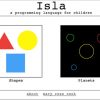What’s brilliant about Isla is that its toylike simplicity–natural language, simple shapes, clear instructions, instant feedback–co-exists with a spartan respect for the realities of grown-up coding. Like the fact that, with all due respect to Scratch and Kodu, most programming still happens in plain text. The box where you type instructions into Isla looks just like a command line, and acts like an IDE (integrated development environment): If you get some syntax wrong, it’ll reject your code with an error message. The difference is that the error messages are in plain english, and gently invite you to think about what you need to change in order to get it right. What’s more, as you follow Isla’s intentionally rote instructions, you’ll naturally start to wonder how to push its boundaries. When Isla asked me to change the color of a circle for the fourth time, I did something different–but still correct according to the rules I’d learned. And poof: Isla responded to my whims, just like a real programming language would. That’s a self-directed learning experience that feels much more empowering and reinforcing, in a Montessori school kind of way, than getting a badge for jumping through some hoops in Codecademy. (via 1 | This Fun Tool Teaches Kids To Program With Pictures | Co.Design: business innovation design)
